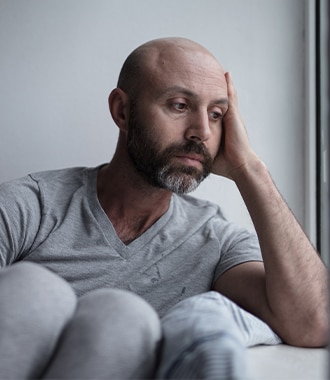Wellness
How to stop panic attacks
Kristi Leksen, MA, Licensed Mental Health Counselor Mar 24, 2025 • 8 min
Every year, up to 11% of people in the U.S. experience a panic attack, and about 2–3% live with chronic panic disorder. If you’ve experienced a panic attack, you may dread the return of intense stress or fear that causes symptoms like chest tightness or pain, a racing heart, trembling, tingling or numbness, a feeling of detachment from your body, or shakiness. Learning strategies to help manage panic attacks and finding out which treatments are available for panic disorder may help reduce anxiety and future occurrences.
What causes panic attacks?
Scientific research has yet to uncover the exact cause of panic attacks. A tendency toward anxiety makes panic attacks more likely, and it’s suggested that genetics, stress, temperament and changes in our brain can increase vulnerability to anxiety and panic attacks. Most experts believe that these factors can trigger a person’s body to rush into fight-or-flight mode even when there’s no real threat to their survival.
Short-term solutions for panic attacks
There are strategies that may be helpful in preventing and managing panic attack symptoms. Not all methods work for everyone, so you may need to experiment with different techniques or combine more than one method for the best results.
1. Recognize what’s happening: Intense fear and dread often accompany panic attacks. Some people report feelings of impending doom or feelings that they may be dying. These feelings and thoughts can make panic attacks more intense and traumatic. Conversely, if you remind yourself in the moment that you’re having a panic attack and reassure yourself that you’re safe, your body may relax, helping to ease symptoms. Try using these phrases:
- This feeling is uncomfortable, but I’m safe.
- I am not having a heart attack. This is just panic.
- I will get through this.
- This is temporary. It will be over soon.
Typing out or writing down the phrases may help. Some people also find it beneficial if others around them reinforce these messages. Teach the phrases to loved ones and ask them to repeat them if you signal that you’re having a panic attack.
2. Change the temperature: For some people, exposure to a sudden temperature shift may help ease panic attacks. Try placing a wrapped ice pack or cool damp cloth on the back of your neck, splash your face with cold water, step outside into cold weather or soak in a cool bath.
3. Tune into the world around you: Distracting yourself from the symptoms of a panic attack may be enough to ease them. Tune your senses into the present moment:
- Look around and name colors or objects you notice in your surroundings.
- Name and count all of the sounds you detect in the world around you.
- Attempt to detect and identify smells.
- Notice what your feet feel like on the ground or engage your sense of touch with a stress-relief gadget or fidget spinner.
- Try moving different parts of your body and focus on how they feel.
4. Take deep breaths: During a panic attack, your heart rate and breathing increase. By consciously slowing down your breath, you may be able to calm your nervous system and get relief from symptoms.
Another popular breathing method is box breathing, where you breathe in for four seconds, hold your breath for four seconds, breathe out for four seconds and hold again for four seconds. Repeat this exercise until you feel calmer.
Although deep breathing helps most people, it may worsen symptoms in others. If this is the case for you, focus on other strategies.
5. Long-term treatment for panic disorder: Healthcare providers typically diagnose a person with panic disorder if they have frequent panic attacks and experience persistent worry about repeat attacks. If you have panic disorder, there are treatments and lifestyle changes that may reduce the frequency and intensity of panic attacks.
6. Medications: Medical providers may prescribe medications for panic attacks and panic disorders, such as:
- Serotonin selective reuptake inhibitors (SSRIs): These antidepressants increase levels of the brain chemical serotonin and may reduce panic attacks. Examples include fluoxetine (Prozac) and paroxetine (Paxil).
- Serotonin-norepinephrine reuptake inhibitors (SNRIs): These antidepressants may reduce panic attacks by increasing levels of serotonin and another brain chemical called norepinephrine. SNRIs used to treat panic disorder include venlafaxine (Effexor).
- Benzodiazepines: These anti-anxiety drugs boost the actions of the brain chemical gamma-aminobutyric acid (GABA) to slow down the central nervous system. Examples include alprazolam (Xanax) and lorazepam (Ativan).
Keep in mind that all medications pose a risk for side effects. Because benzodiazepines can be addictive, healthcare providers may try other drugs as first-line treatments.
7. Psychotherapy: Gaining an understanding of why panic attacks occur and discussing your feelings about them may help you better cope with symptoms and potentially reduce the frequency of attacks. Your healthcare provider may refer you to a mental health professional for psychotherapy or “talk therapy.” If your symptoms occur after a trauma, a post-traumatic stress disorder therapy such as eye movement desensitization and reprocessing (EMDR) may be beneficial.
A common treatment for panic attacks is cognitive behavioral therapy (CBT). Through CBT, you can learn to recognize the physical sensations and emotional symptoms of panic attacks as they begin and then use constructive thinking to help cope. CBT can also help you explore sources of stress and potential anxiety triggers in your life so that you can find ways to address them.
8. Exercise: Regular aerobic activity like brisk walking, swimming and cycling may ease anxiety and lead to fewer panic attacks. A 2019 meta-analysis of 14 cohort studies found that people with anxiety and panic disorders who exercised regularly reported significant improvements in their symptoms.
9. Avoid stimulants: Stimulants like caffeine increase the activity of the central nervous system. For some people, the effects can worsen panic attacks. Try avoiding or reducing your intake of coffee, tea, energy drinks, caffeinated sodas and chocolate to see if that helps reduce the frequency or intensity of panic attacks.
The first step toward stopping panic attacks is seeking help. If panic attacks or worrying about having future attacks interferes with your daily life, contact your healthcare provider. You should also let them know if your panic attacks have recently become more frequent or intense. Your provider can explore treatment options with you and offer specific lifestyle tips that can benefit your mental health.
Updated March 2025.
Sources:
- https://www.nebraskamed.com/behavioral-health/do-candy-warheads-stop-panic-attacks-5-panic-attack-hacks-that-work
- https://health.clevelandclinic.org/how-to-stop-a-panic-attack/
- https://www.mayoclinic.org/diseases-conditions/panic-attacks/diagnosis-treatment/drc-20376027
- https://my.clevelandclinic.org/health/diseases/4451-panic-disorder
- https://www.nimh.nih.gov/health/publications/panic-disorder-when-fear-overwhelms
- https://onlinelibrary.wiley.com/doi/abs/10.1002/da.22915
- https://www.merckmanuals.com/home/mental-health-disorders/anxiety-and-stress-related-disorders/panic-attacks-and-panic-disorder
- https://www.va.gov/WHOLEHEALTHLIBRARY/tools/diaphragmatic-breathing.asp
- https://www.nami.org/About-Mental-Illness/Treatments/Psychotherapy


